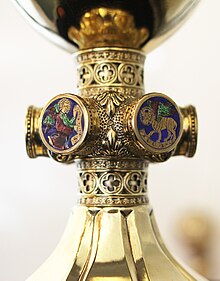Wolfurt Chalice
The Wolfurt chalice is a silver measuring chalice that a knight Konrad von Wolfurt gave to Pfäfers monastery in 1364 . The liturgical device is particularly valuable, as the foundation document has been preserved in addition to the chalice - a very rare constellation.
description
The Wolfurt chalice is chased, engraved, punched, gilded and enamelled from silver. It is 19.5 cm high and weighs 900 g; the kuppa (bowl) has a diameter of 13 cm. The round base is adorned with flattened, lanceolate leaves. Six round rotuli show the four evangelist symbols and the coat of arms of the village Wolfurt near Bregenz in Vorarlberg, which is still used today , in enamel . On the edge of the foot there is the inscription: CVNRADVS DE WOLFVRT MILES VIRGINE MARIE HVNC CALICEM DONAVIT.
The Knights of Wolfurt
The Lords of Wolfurt appear for the first time in 1219. The Wolfurt local history researcher Siegfried Heim attributes the name Wolfurt to a Scottish knight named M'Dewr the Wolf, who received Wolfurt Castle as a fief from Emperor Barbarossa . In the 14th century, the family of the Wolfurt knights, which has since expanded widely, owned ten other castles in southern Germany, nine in Hungary and one in Italy (Guglionesi) in addition to the ancestral castle in Wolfurt. Around 100 years later - in the first half of the 15th century - the noble von Wolfurt clan disappears. They died out, became impoverished or became citizens in the cities.
Knight Konrad as donor of the chalice
At the time of the heyday of the Knights of Wolfurt, the brothers Konrad and Ulrich appeared. They served King Ludwig I as a mercenary leader at the side of the mercenary leader Werner von Urslingen and in 1348 conquered the Kingdom of Naples. They looted the cities of Foggia , Capua and Aversa , among others . They made rich booty with murder, extortion and pillage. According to Siegfried Heim (volume 24, p. 10), the mercenary leader Konrad von Wolfurt is also the founder of the Wolfurt chalice. The deed of foundation speaks of his regret about his crimes: "Knight Konrad (asks) for the salvation of his soul (...) and for the salvation of all those who have been injured by him in body and property, physically or in any other way."
However, there are contradictions in the literature due to the frequent use of the name "Konrad von Wolfurt". For example, with Karl-Heinz Burmeister (p. 17) the mercenary leader Konrad is not the founder of the chalice. According to Burmeister, the chalice donor Konrad is the one who bought the castle and town of Arbon in 1365 and died shortly after 1369. Burmeister states that the fate of the mercenary leader Konrad is uncertain (p. 17).
History of the chalice
The Wolfurt chalice was kept in Pfäfers monastery until 1838, when it came into the possession of the parish and was sold in 1884. In 1886, Dr. Heinrich Angst sold the chalice in the art trade, in 1903 he gave the chalice to the Swiss National Museum , where it is kept today. After Wolfurt was raised to a market town in 1982 , the then mayor Hubert Waibel had a copy of the chalice made by the silversmith's workshop in Spitzbarth in Zurich. The chalice was presented to the public in 1985 and is now on display in the town hall. The deed of foundation, dated September 20, 1364, is in the St. Gallen Abbey Archives .
literature
- Anna Rapp: The Wolfurt Chalice from 1364 . In: Elmar Vonbank (ed.): Die Wolfurter (exhibition catalog of the Vorarlberger Landesmuseum ; Vol. 99). Vorarlberger Landesmuseum, Bregenz 1982 (catalog of the exhibition of the same name, May 1 to 23, 1982).
- Karl Heinz Burmeister : The noble knights of Wolfurt . In: Die Wolfurter. Exhibition catalog of the Vorarlberger Landesmuseum No. 99. Ed. Vorarlberger Landesmuseum, Bregenz 1982
- Siegfried Heim: Wolfurt and Wolford (Heimat Wolfurt; Issue 24). Wolfurt Local History District, May 2000.
- Günther E. Natsch: The Wolfurt chalice from Pfäfers. History about a "measuring cup for salvation" . Self-published, Bad Ragaz 1998.
Web links
- The local history magazine, issue 24 (PDF; 5.8 MB) as an online version on the Internet
- The Wolfurt chalice on the homepage of the market town of Wolfurt.
Individual evidence
- ^ Erwin Rothenhausler, Erwin Poeschel: The art monuments of the canton of St. Gallen . In: Art Monuments of Switzerland . tape 25 . Birkhäuser, 1951, p. 212 .
- ^ Swiss National Museum website, photo from the collection

